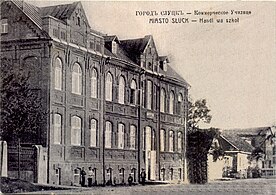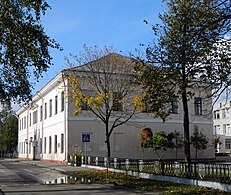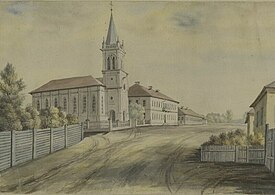| Slutsk Слуцк | |
|---|---|
| Town | |
 Memorial to Princess Anastasia Slutskaya Memorial to Princess Anastasia Slutskaya | |
 Flag Flag Coat of arms Coat of arms | |
 | |
| Coordinates: 53°02′N 27°34′E / 53.033°N 27.567°E / 53.033; 27.567 | |
| Country | Belarus |
| Region | Minsk Region |
| District | Slutsk District |
| Founded | 1116 |
| Area | |
| • Total | 24.6 km (9.5 sq mi) |
| Elevation | 250 m (820 ft) |
| Population | |
| • Total | 60,056 |
| • Density | 2,400/km (6,300/sq mi) |
| Time zone | UTC+3 (MSK) |
| Postal code | 223610 |
| Area code | +375 1795 |
| License plate | 5 |
| Website | Official website |
Slutsk (Belarusian: Слуцк, romanized: Sluck; Russian: Слуцк; Polish: Słuck, Lithuanian: Sluckas, Yiddish/Hebrew: סלוצק) is a town in Minsk Region, Belarus. It serves as the administrative center of Slutsk District, and is located on the Sluch River 105 km (65 mi) south of the capital Minsk. As of 2024, it has a population of 60,056.
Geography
The city is situated in the south-west of Minsk Region, 26 km (16 mi) north of Salihorsk.
Climate
| Climate data for Slutsk (1991–2020) | |||||||||||||
|---|---|---|---|---|---|---|---|---|---|---|---|---|---|
| Month | Jan | Feb | Mar | Apr | May | Jun | Jul | Aug | Sep | Oct | Nov | Dec | Year |
| Record high °C (°F) | 4.5 (40.1) |
5.7 (42.3) |
13.7 (56.7) |
22.9 (73.2) |
27.4 (81.3) |
29.9 (85.8) |
31.6 (88.9) |
31.3 (88.3) |
26.4 (79.5) |
20.0 (68.0) |
12.3 (54.1) |
6.4 (43.5) |
31.6 (88.9) |
| Mean daily maximum °C (°F) | −1.6 (29.1) |
−0.4 (31.3) |
5.2 (41.4) |
13.6 (56.5) |
19.4 (66.9) |
22.8 (73.0) |
24.8 (76.6) |
24.4 (75.9) |
18.4 (65.1) |
11.3 (52.3) |
4.3 (39.7) |
−0.2 (31.6) |
11.8 (53.2) |
| Daily mean °C (°F) | −4.1 (24.6) |
−3.4 (25.9) |
0.9 (33.6) |
8.0 (46.4) |
13.6 (56.5) |
17.1 (62.8) |
19.0 (66.2) |
18.2 (64.8) |
12.9 (55.2) |
7.0 (44.6) |
1.8 (35.2) |
−2.5 (27.5) |
7.4 (45.3) |
| Mean daily minimum °C (°F) | −6.8 (19.8) |
−6.4 (20.5) |
−2.8 (27.0) |
2.8 (37.0) |
7.8 (46.0) |
11.3 (52.3) |
13.2 (55.8) |
12.3 (54.1) |
7.9 (46.2) |
3.4 (38.1) |
−0.5 (31.1) |
−4.8 (23.4) |
3.1 (37.6) |
| Record low °C (°F) | −20.5 (−4.9) |
−18.4 (−1.1) |
−11.9 (10.6) |
−3.6 (25.5) |
0.4 (32.7) |
4.6 (40.3) |
7.8 (46.0) |
6.1 (43.0) |
0.3 (32.5) |
−4.5 (23.9) |
−9.8 (14.4) |
−15.7 (3.7) |
−20.5 (−4.9) |
| Average precipitation mm (inches) | 41.2 (1.62) |
34.6 (1.36) |
37.5 (1.48) |
36.8 (1.45) |
64.1 (2.52) |
79.7 (3.14) |
88.8 (3.50) |
61.1 (2.41) |
47.3 (1.86) |
49.7 (1.96) |
43.0 (1.69) |
44.1 (1.74) |
627.9 (24.72) |
| Average precipitation days (≥ 1.0 mm) | 10.5 | 9.1 | 8.8 | 7.5 | 9.8 | 9.5 | 10.3 | 7.3 | 7.4 | 8.5 | 9.7 | 10.6 | 109.0 |
| Source: NOAA | |||||||||||||
History

Slutsk was first mentioned in writing in 1116. It was initially part of the Principality of Turov and Pinsk but in 1160 became the capital of a separate principality. From 1320–1330, it was part of the domain of the Grand Duchy of Lithuania. Casimir IV Jagiellon vested it with Magdeburg town rights in 1441. It was a private town, owned by the Olelkovich and Radziwiłł families, which transformed it into a center of the Polish Reformed Church with a gymnasium and a strong fortress.
The first Jewish residents arrived by the late 16th century, expanding in population over the following centuries until the town was majority Jewish from the 19th century until World War II. In the mid-17th century, Scottish immigrants settled in the town.
Following the 17th century, the city became famous for manufacturing kontusz belts, some of the most expensive and luxurious pieces of garment of the szlachta. Because of the popularity of the cloths made here, belts worn over the żupan were often called of Slutsk despite their real place of origin.
In 1778, it became a county seat within the Nowogródek Voivodeship. Slutsk was part of the Russian Empire after the Second Partition of Poland in 1793. It was occupied by Germany in 1918 and by Poland between 1919 and 1920 during Polish–Soviet War. In 1920, it was the centre of a major anti-bolshevik uprising known as the Slutsk defence action.
Until World War II and the Slutsk Affair, the city was predominantly Jewish; however, now the population includes no more than 100 Jews.
Slutsk was occupied by the German Army on 26 June 1941, and placed under the administration of Reichskommissariat Ostland. The period of German occupation ended on 30 June 1944, when troops of the 1st Belorussian Front recaptured the town during the Minsk Offensive of the Red Army.
On 2 October 1967, a riot occurred during which the local court building was set on fire, resulting in the death of a judge and a police officer. The riot, unprecedented in post-WW2 Soviet Belarus, was triggered by the conduct of a murder trial, which was perceived to be unjust by the local residents.
Jewish community
The first indication of Jews in Slutsk is from 1583 when the city was part of Lithuania. Formal recognition came in 1601. By 1623, Jews owned 16 homes. In 1691, Slutsk became one of the five leading communities of the Lithuanian Jewish Council. By 1750 there were 1,593 Jewish people, accounting for one third of the population. In economic life, Jewish people were concentrated in commerce; three-fourths of the town's merchants were Jewish, and a similar share of people in the alcohol business were Jewish. After annexation by Russia in 1793, growth of the city slowed, in part due to it being bypassed by the railroad. By 1897 the Jewish community numbered 10,264 inhabitants, or 77% of the city population. They played a central role in the cities markets, particularly in agricultural produce.

Slutsk was important in terms of Torah study. Among the rabbinic figures who served there were Yehudah Leib Pohovitser, Chayim ha-Kohen Rapoport, Yosef Dov Ber Soloveichik (1865–1874), and Isser Zalman Meltzer. The famous Slutsk-Kletsk Yeshiva was founded in Slutsk in 1883 by Rabbi Yaakov Dovid Wilovsky. Another outstanding scholar of learning in the Talmud and Torah who was also a Hebrew poet and became a Hebrew educator in the United States was Ephraim Eliezer Lisitzky, who was born and grew to his teens in Slutsk before emigrating to the U.S. According to legend the Baal Shem Tov visited Slutsk in 1733 at the invitation of Shmuel Ickowicz. Despite this, the town was known for its anti-hasidic misnagdim. The Haskalah and modern Jewish political parties also were represented among the population.
Massacre of Jews
During the German occupation of Slutsk, the Jewish inhabitants were systematically targeted for killing. The first Jewish victims were killed in the garden on Monakhov Street during the initial days immediately following the arrival of the Germans on 27 June 1941. The victims numbered between 70 and 120, according to different sources.

Four months later, on 27 and 28 October 1941, one of the largest single massacres occurred, known as the Slutsk affair, when Jews were herded towards pits in the Gorovakha ravine, approximately 10 km (6.2 mi) west of Slutsk, where they were shot. According to German sources the total number of victims was 3,400, while Soviet sources cite 8,000. These killings were carried out by two companies of the German 11th Reserve Order Police Battalion and the Lithuanian 2nd Battalion, which was a German-sponsored Schutzmannschaft or Auxiliary Police formation established in Kaunas, soon after the Nazi occupation of Lithuania.
A further massacre was carried out over several days during the spring of 1942, when the inhabitants of the "field ghetto" of Slutsk were taken to the forest near the village of Bezverkhovichi, 10 km (6.2 mi) west of Slutsk, where they were shot or murdered in gas vans. According to survivors, the victims were driven to the execution site in two to four trucks on Mondays and Saturdays. The last Jews of the field ghetto were murdered on the Passover, 2–3 April 1942. The total number of Jews murdered at Bezverkhovichi is estimated to have been between 3,000 and 4,000.
One of the last significant massacres of Jews occurred on 8 February 1943, with the liquidation of the "town ghetto" of Slutsk. The Jews were driven in trucks to the former estate of Mokhart, popularly called Mokharty, 5 km (3.1 mi) east of Slutsk, where they were shot from behind in mass graves by personnel of the Minsk security police office. During the liquidation, some Jews fought back, shooting at the German and Latvian soldiers. In response, the Germans burnt the ghetto to the ground. Postwar court proceedings cite a minimum of 1,600 victims, of which 1,200 were murdered at the graves at Mokharty, the rest in the ghetto itself.
Notable people
- Isaac Dov Berkowitz – Jewish and Israeli author
- Eliyahu Feinstein – rabbinic authority
- Yaakov Yosef Herman – Orthodox Jewish pioneer in America
- Semyon Kosberg – Jewish Soviet engineer
- Shneur Kotler – rosh yeshiva, Lakewood yeshiva
- Boruch Ber Leibowitz – leading rosh yeshiva
- Isser Zalman Meltzer – Rabbi of Slutsk from 1903 to 1923
- Artur Nepokoychitsky (1813–1881) – Imperial Russian military leader
- Anastasiya Prokopenko – world champion and Olympic bronze medalist in modern pentathlon
- Gregory Razran (1901–1973) – Russian American psychologist
- Princess Sophia of Slutsk – medieval Eastern Orthodox saint
- Fabijan Šantyr (1887–1920) – Belarusian poet, writer and public figure who is regarded as “the first victim of in…Belarusian politics and literature”
- Edward Sperling – Jewish writer and humorist
- Mikola Statkevich – Belarusian politician
- Meyer Waxman – Rabbi and author
- Mikhail Yakimovich – Belarusian handball player
- Lidia Yermoshina – Belarusian politician
- Shaul Yisraeli – religious Zionist rabbi
Twin towns — sister cities
See also: List of twin towns and sister cities in Belarus| This article needs to be updated. Please help update this article to reflect recent events or newly available information. (June 2022) |
Slutsk is twinned with:
 Brovary Raion, Ukraine
Brovary Raion, Ukraine Kalevalsky District, Russia
Kalevalsky District, Russia Moshenskoy District, Russia
Moshenskoy District, Russia Ryazansky (Moscow), Russia
Ryazansky (Moscow), Russia Rzhev, Russia
Rzhev, Russia Serpukhovsky District, Russia
Serpukhovsky District, Russia Shaki, Azerbaijan
Shaki, Azerbaijan Sisian, Armenia
Sisian, Armenia Staromaynsky District, Russia
Staromaynsky District, Russia
Former twin towns:
 Tczew, Poland
Tczew, Poland
On 8 March 2022, the Polish city of Tczew ended its partnership with Slutsk as a response to the Belarusian involvement in the 2022 Russian invasion of Ukraine.
Gallery
-
 Slutsk train station
Slutsk train station
-
 Slutsk bus depot in the 1920s
Slutsk bus depot in the 1920s
-
 Slutsk Homeland Museum
Slutsk Homeland Museum
-
 Cinema-Theatre "Belarus"
Cinema-Theatre "Belarus"
-
 Commercial college
Commercial college
-
Painting of the Slutsk Defence Action
-
 Slutsk high school
Slutsk high school
-
 The high school, "The oldest school in Slutsk"
The high school, "The oldest school in Slutsk"
-
 Native Belarusian man
Native Belarusian man
-
 Studying Talmud in Slutsk
Studying Talmud in Slutsk
-
 The Slutsk River
The Slutsk River
See also
- Slutsk Affair
- Slutsk defence action
- Slutsky
- The Holocaust in Byelorussia
- List of cities and towns in Belarus
- Pas kontuszowy
- Słuck Confederation
Notes
References
- ^ "Численность населения на 1 января 2024 г. и среднегодовая численность населения за 2023 год по Республике Беларусь в разрезе областей, районов, городов, поселков городского типа". belsat.gov.by. Archived from the original on 2 April 2024. Retrieved 9 April 2024.
- "World Meteorological Organization Climate Normals for 1991-2020 — Slutsk". National Oceanic and Atmospheric Administration. Retrieved January 13, 2024.
- Słownik geograficzny Królestwa Polskiego i innych krajów słowiańskich, Tom X (in Polish). Warszawa. 1889. p. 838.
{{cite book}}: CS1 maint: location missing publisher (link) - ^ Adam Teller, "Slutsk," YIVO Encyclopedia of Jews in Eastern Europe, (19 October 2010), accessed 25 January 2015.
- ^ Słownik geograficzny Królestwa Polskiego i innych krajów słowiańskich, Tom X (in Polish). Warszawa. 1889. p. 839.
{{cite book}}: CS1 maint: location missing publisher (link) - 52 гады таму жыхары Слуцку ўзбунтаваліся, спалілі суд разам з судзьдзёй. Новы паварот справы (52 years ago the residents of Slutsk rioted and set on fire the court building together with a judge. New turn of this case
- "The Untold Stories - Slutsk". Yad Vashem, the World Holocaust Remembrance Center.
- "Garden on Monakhov Street in Slutsk". Yad Vashem, the World Holocaust Remembrance Center.
- "Gorovakha Ravine". Yad Vashem, the World Holocaust Remembrance Center.
- MacQueen, Michael (2004). "LITHUANIAN COLLABORATION IN THE "FINAL SOLUTION"" (PDF). CENTER FOR ADVANCED HOLOCAUST STUDIES UNITED STATES HOLOCAUST MEMORIAL MUSEUM. p. 5.
- "Bezverkhovichi (Gas Vans)". Yad Vashem, the World Holocaust Remembrance Center.
- "Former Mokharty Estate". Yad Vashem, The World Holocaust Remembrance Center.
- "Фабіян Шантыр: Аўтар "Нашай нівы" і першая ахвяра бальшавіцкага тэрору ў беларускай палітыцы і літаратуры" .Archived 2021-08-09 at the Wayback Machine baj.by (in Belarusian).
- "Внешнеэкономическая деятельность". slutsk.minsk-region.by (in Russian). Slutsk. Retrieved 2020-01-14.
- "Tczew zrywa współpracę z miastami partnerskimi z Rosji i Białorusi" (in Polish). Retrieved 13 March 2022.
External links
Further reading
- J. Krajcar, S.J. (1975). "The last Princes of Sluck and the West". The Journal of Byelorussian Studies. III (3): 269–287. Retrieved 3 June 2024.
| Districts (raiony) |  | |
|---|---|---|
| Cities and towns | ||
| Administrative center of Minsk Region but administratively separated | ||